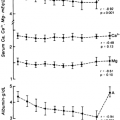CLONING OF GENES
Complementary DNA Libraries.
The cloning of a particular expressed gene begins with the preparation and cloning of cDNAs from mRNAs of a particular cell (Fig. 2-1; Table 2-1) (for a more comprehensive description, see reference 11 and reference 12). The cDNAs are prepared by priming the reverse transcription of mRNAs, using reverse transcriptase and short oligonucleotide fragments of oligodeoxyribothymidine, which preferentially bind to the 3′-polyadenylate, or poly(A), tract that is characteristic of cellular mRNAs. Alternatively, random oligonucleotides of different base compositions may be used. Double-stranded DNA is then prepared from the single-stranded cDNA by using DNA polymerase, and the cDNAs are inserted into bacterial plasmids that have been cleaved at a single site with a restriction endonuclease. To ensure a reasonably high efficiency of insertion of the foreign DNA into the plasmids, cohesive, or “sticky,” ends are first prepared by adding short DNA
sequences to the ends of the foreign DNA and to the plasmids. Vectors that are commonly used are derivatives of the plasmid pBR322, which was engineered specifically for the purposes of cloning DNA fragments (see Fig. 2-1). Foreign DNA is inserted into a unique site that is prepared by endonuclease cleaving of a desired site within a polylinker, multiple cloning site engineered into the plasmid. This site is often located within the gene that codes for bacterial β-galactosidase. The backbone plasmid also carries a gene for resistance to ampicillin or tetracycline. Thus, bacteria containing the plasmids can be selected by their resistance to ampicillin or tetracycline; those specifically containing DNA inserts can be selected by their inability to express β-galactosidase and to cleave β-galactopyranoside (blue-white screening).
sequences to the ends of the foreign DNA and to the plasmids. Vectors that are commonly used are derivatives of the plasmid pBR322, which was engineered specifically for the purposes of cloning DNA fragments (see Fig. 2-1). Foreign DNA is inserted into a unique site that is prepared by endonuclease cleaving of a desired site within a polylinker, multiple cloning site engineered into the plasmid. This site is often located within the gene that codes for bacterial β-galactosidase. The backbone plasmid also carries a gene for resistance to ampicillin or tetracycline. Thus, bacteria containing the plasmids can be selected by their resistance to ampicillin or tetracycline; those specifically containing DNA inserts can be selected by their inability to express β-galactosidase and to cleave β-galactopyranoside (blue-white screening).
Stay updated, free articles. Join our Telegram channel

Full access? Get Clinical Tree





